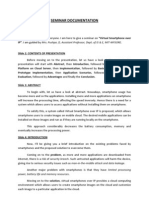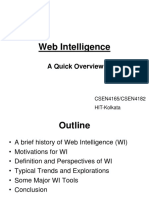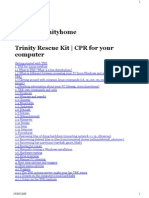0 ratings0% found this document useful (0 votes)
341 viewsDrowsiness Detection
Drowsiness Detection
Uploaded by
Ashalatha MadasuThe document describes a proposed method for robust head tracking to detect driver drowsiness using multiple cues like eye movement, iris detection, and head position fused within a kernel-Bayesian framework. The method uses a webcam and microcontroller to capture visual cues which are analyzed using openCV to determine alertness level. If drowsiness is detected, a buzzer is activated to warn the driver. The system was designed and tested using Raspberry Pi with Linux OS, Qt for embedded development, and openCV library.
Copyright:
© All Rights Reserved
Available Formats
Download as PPTX, PDF, TXT or read online from Scribd
Drowsiness Detection
Drowsiness Detection
Uploaded by
Ashalatha Madasu0 ratings0% found this document useful (0 votes)
341 views16 pagesThe document describes a proposed method for robust head tracking to detect driver drowsiness using multiple cues like eye movement, iris detection, and head position fused within a kernel-Bayesian framework. The method uses a webcam and microcontroller to capture visual cues which are analyzed using openCV to determine alertness level. If drowsiness is detected, a buzzer is activated to warn the driver. The system was designed and tested using Raspberry Pi with Linux OS, Qt for embedded development, and openCV library.
Original Description:
It is about the project to detect the drowsiness of the person using eog sensor
Original Title
drowsiness detection ppt
Copyright
© © All Rights Reserved
Available Formats
PPTX, PDF, TXT or read online from Scribd
Share this document
Did you find this document useful?
Is this content inappropriate?
The document describes a proposed method for robust head tracking to detect driver drowsiness using multiple cues like eye movement, iris detection, and head position fused within a kernel-Bayesian framework. The method uses a webcam and microcontroller to capture visual cues which are analyzed using openCV to determine alertness level. If drowsiness is detected, a buzzer is activated to warn the driver. The system was designed and tested using Raspberry Pi with Linux OS, Qt for embedded development, and openCV library.
Copyright:
© All Rights Reserved
Available Formats
Download as PPTX, PDF, TXT or read online from Scribd
Download as pptx, pdf, or txt
0 ratings0% found this document useful (0 votes)
341 views16 pagesDrowsiness Detection
Drowsiness Detection
Uploaded by
Ashalatha MadasuThe document describes a proposed method for robust head tracking to detect driver drowsiness using multiple cues like eye movement, iris detection, and head position fused within a kernel-Bayesian framework. The method uses a webcam and microcontroller to capture visual cues which are analyzed using openCV to determine alertness level. If drowsiness is detected, a buzzer is activated to warn the driver. The system was designed and tested using Raspberry Pi with Linux OS, Qt for embedded development, and openCV library.
Copyright:
© All Rights Reserved
Available Formats
Download as PPTX, PDF, TXT or read online from Scribd
Download as pptx, pdf, or txt
You are on page 1of 16
ROBUST HEAD TRACKING
BASED ON MULTIPLE CUES
FUSION IN THE KERNEL-
BAYESIAN FRAMEWORKS
OBJECTIVE
The main objective of the project is to ROBUST
HEAD TRACKING BASED ON MULTIPLE
CUES FUSION IN THE KERNEL-BAYESIAN
FRAMEWORKS.
EXISTING METHOD
In the existing method we can detect the visual
information by using sensors and after detecting it
rings buzzer to indicate that driver is not paying
attention on driving and after buzzer rings driver
will come to normal position and he will
concentrate on driving.
DISADVANTAGES OF EXISTING
SYSTEM:
In the existing method the main disadvantage is we
are detecting eyes by using sensors but we are not
identifying exactly weather the driver paying
attention on driving or not.
PROPOSED METHOD
In the proposed method the on line detection of drowsiness using brain
and visual information is to monitor the driver attentiveness in cars.
This project is to monitor the drivers eye movement, IRIS detection, eye
lids and head detection.
Our Embedded project is to design and develop a low cost feature which is
based on embedded platform for finding the driver drowsiness.
Specifically, our system includes a webcam placed on the steering column
which is capable to capture all the eye movements of the Driver to find out
whether he is sleeping or not.
If the driver is not paying attention on the road ahead trying to sleep, the
system will warn the driver by giving the warning sounds in the form of
buzzer.
Our Embedded System uses ARM micro controller has a feature of image
processing technique. Image processing is any form of signal processing
for which the input is an image, such as a photograph or video frame; the
output of image processing may be either an image or a set of
characteristics or parameters related to the image.
BLOCK DIAGRAM
ARM
ARCHITECTURE
REGULATED POWER
SUPPLY
USB HOST
WEBCAM
BUZZER
LINUX OS
APPLICATION
FRAME WORK
IMPLEMENTTION
For implementing this project we are using Linux, Qt
for embedded Linux and open CV library.
LINUX OPERATING SYSTEM
The Linux open source operating system, or
Linux OS, is a freely distributable, cross-
platform operating system based on Unix that
can be installed on PCs, laptops, net books,
mobile and tablet devices, video game consoles,
servers, supercomputers and more.
Qt for Embedded Linux
Qt for Embedded Linux is a C++ framework for
GUI and application development for embedded
devices.
It runs on a variety of processors, usually with
Embedded Linux.
Qt for Embedded Linux provides the standard Qt
API for embedded devices with a lightweight
window system.
OPEN CV
Open CV is an open source computer vision
library originally developed by Intel.
It is free for commercial and research use under
a BSD (Berkeley Software Distribution) license.
The library is cross-platform, and runs on Linux,
Windows and Mac OS X.
It focuses mainly towards real-time image
processing, as such, if it finds Intel's Integrated
Performance Primitives on the system, it will use
these commercial optimized routines to accelerate
itself.
Working Principle
In this section, we are giving the complete description on the
proposed system architecture. Here we are using Raspberry Pi
board as our platform. It has an ARM-11 SOC with integrated
peripherals like USB, Ethernet and serial etc.
On this board we are installing Linux operating system with
necessary drivers for all peripheral devices and user level
software stack which includes a light weight GUI based on
XServer, V4L2 API for interacting with video devices like
cameras, TCP/IP stack to communicate with network devices
and some standard system libraries for system level general
IO operations.
The Raspberry Pi board equipped with the above software
stack is connected to the outside network and a camera is
connected to the Raspberry Pi through USB bus. On the other
side we have to host a web server with cloud facility.
Contd
The system uses USB webcam which is places at fore
head of visually impaired person and is connected to
Raspberry PI board through USB device.
After connecting all the devices power up the device.
When the device starts booting from flash, it first loads
the linux to the device and initializes all the drivers and
the core kernel.
After initialization of the kernel it first checks weather all
the devices are working properly or not.
After that it loads the file system and starts the startup
scripts for running necessary processes and daemons.
Finally it starts the main application.
Contd
When our application starts running it first check all the
devices and resources which it needs are available or not.
After that it checks the connection with the devices and gives
control to the user. The GUI for the user has the following
options.
An optional label for displaying the image taken from the
camera.
A status box for representing whether drowsiness is detected
or not.
Proposed scheme uses visual features such as eye index (EI),
pupil activity (PA), and HP to extract critical information on
non alertness of a vehicle driver.
EI determines if the eye is open, half closed, or closed from
the ratio of pupil height and eye height. PA measures the rate
of deviation of the pupil center from the eye center over a time
period.
Contd
Our Embedded project is to design and develop a low
cost feature which is based on embedded platform
for finding the driver drowsiness.
Specifically, our system includes a webcam placed on
the steering column which is capable to capture the
eye movements.
If the driver is not paying attention on the road
ahead and a dangerous situation is detected, the
system will warn the driver by giving the warning
sounds through buzzer.
CONCLUSION
The project ROBUST HEAD TRACKING BASED ON
MULTIPLE CUES FUSION IN THE KERNEL-BAYESIAN
FRAMEWORKS has been successfully designed and
tested.
It has been developed by integrating features of all
the hardware components and software used.
Presence of every module has been reasoned out and
placed carefully thus contributing to the best
working of the unit.
Secondly, using highly advanced Raspberry pi board
and with the help of growing technology the project
has been successfully implemented.
APLLICATION LANGUAGE: C / C++
ADVANTAGES:
It avoids the accidents while driving.
Automatic monitoring system.
It avoids potential human errors.
APPLICATIONS:
It is used to give warning sounds for driver
drowsiness while driving.
REFERENCE:
Datasheets and the user manuals of ARM controller.
Beginning of Linux programming by Neil Matthew,
Richard Stones.
You might also like
- Multi Factor Authentication A Complete Guide - 2020 EditionFrom EverandMulti Factor Authentication A Complete Guide - 2020 EditionNo ratings yet
- Volte SRVCCDocument22 pagesVolte SRVCCanoopreghuNo ratings yet
- FinalDocument33 pagesFinalanushaNo ratings yet
- Driver Drowsiness Detection SystemDocument10 pagesDriver Drowsiness Detection SystempranavNo ratings yet
- Real-Time Driver Drowsiness Detection System Using Facial FeaturesDocument7 pagesReal-Time Driver Drowsiness Detection System Using Facial FeaturesIJRASETPublicationsNo ratings yet
- Real-Time Driver-Drowsiness Detection System Using Facial FeaturesDocument12 pagesReal-Time Driver-Drowsiness Detection System Using Facial FeaturesthefakestudentNo ratings yet
- Software Requirement SpecificationDocument13 pagesSoftware Requirement Specificationtasnia iqbalNo ratings yet
- Intelligent Wireless Video CameraDocument2 pagesIntelligent Wireless Video CameraMurali Sammeta100% (1)
- Light Peak PresentationDocument30 pagesLight Peak PresentationSimer SahniNo ratings yet
- All About OpenGL ES 2.x - (Part 2 - 3)Document58 pagesAll About OpenGL ES 2.x - (Part 2 - 3)Ivan Arley Osorio FigueroaNo ratings yet
- Human Controlled Robotic Hand Using Gesture RecognitionDocument3 pagesHuman Controlled Robotic Hand Using Gesture RecognitionSvs Pavan Kumar KonderuNo ratings yet
- Eye Tracking Based Driver Fatigue Monitoring and Warning - Hardeep Singh Ece - Hardeep@Document30 pagesEye Tracking Based Driver Fatigue Monitoring and Warning - Hardeep Singh Ece - Hardeep@HARDEEP SINGHNo ratings yet
- 56.eye Ball Cursor Movement Using OpencvDocument4 pages56.eye Ball Cursor Movement Using OpencvAarthi SinghNo ratings yet
- ROSbot Autonomous Robot With LiDARDocument10 pagesROSbot Autonomous Robot With LiDARManuel Armindo RibeiroNo ratings yet
- Line Follower RobotDocument5 pagesLine Follower Robotsud93100% (2)
- Blue Eyes TechnologyDocument10 pagesBlue Eyes Technologygadde bharatNo ratings yet
- Sensors On 3D DigitizationDocument19 pagesSensors On 3D DigitizationRajendra KumarNo ratings yet
- Pantech - Embedded, IoT & Robotic Projects 2021-22Document10 pagesPantech - Embedded, IoT & Robotic Projects 2021-22Kishore RNo ratings yet
- Driver Drowsiness Detection - (Sample) Project Synopsis ReportDocument16 pagesDriver Drowsiness Detection - (Sample) Project Synopsis ReportRitik SinghNo ratings yet
- Robotic Shoe PolisherDocument16 pagesRobotic Shoe Polisherapi-233164756No ratings yet
- Driver Drowsiness SynopsisDocument11 pagesDriver Drowsiness Synopsisakshat shakarwalNo ratings yet
- Smart Pesticide & Fertilizer Spraying RobotDocument6 pagesSmart Pesticide & Fertilizer Spraying RobotJiiva GopiNo ratings yet
- Intro To Vision Sensors ENDocument12 pagesIntro To Vision Sensors ENYogyBear43No ratings yet
- UID Note Chapter 1 3Document23 pagesUID Note Chapter 1 3Kiran KhanalNo ratings yet
- Human Following Robot-2 PDFDocument7 pagesHuman Following Robot-2 PDFSUDEEPTA CHANDRA PAULNo ratings yet
- Quick Start To Nodemcu (Esp8266) On Arduino IdeDocument23 pagesQuick Start To Nodemcu (Esp8266) On Arduino Idejovicarad100% (1)
- Object Counting and Density Calculation Using MatlabDocument46 pagesObject Counting and Density Calculation Using Matlabilg1No ratings yet
- Women Safety Night Patrolling RobotDocument8 pagesWomen Safety Night Patrolling RobotIJRASETPublicationsNo ratings yet
- Final PPT (Autosaved)Document34 pagesFinal PPT (Autosaved)KARTHIK.K 18BEC023No ratings yet
- Detection of Drowsiness and Fatigue Level of Driver: Shreya P. Patel Bhumika P. PatelDocument6 pagesDetection of Drowsiness and Fatigue Level of Driver: Shreya P. Patel Bhumika P. PatelBhumika PatelNo ratings yet
- 08 Robot Sensor MotorDocument29 pages08 Robot Sensor MotoraDun iDeiNo ratings yet
- IOT SYNOPSIS Rev FinalDocument23 pagesIOT SYNOPSIS Rev FinalSandeep Shah100% (1)
- Gesture Controlled RobotDocument36 pagesGesture Controlled RobotTeena Sharma44% (9)
- "IOT Based Water Pollution Monitoring RC Boat": Prepared byDocument21 pages"IOT Based Water Pollution Monitoring RC Boat": Prepared byMiracle AlignerNo ratings yet
- Hand Gesture Controlled RobotDocument65 pagesHand Gesture Controlled RobotFaheem RaoNo ratings yet
- Iot Based Ambulance Tracking With Patient Health Monitoring SystemDocument3 pagesIot Based Ambulance Tracking With Patient Health Monitoring SystemdileeppatraNo ratings yet
- Traffic Analysis Based On Digital Image Processing in PythonDocument7 pagesTraffic Analysis Based On Digital Image Processing in Pythonpraveena.sNo ratings yet
- Gesture Hand Control Car - ReportDocument15 pagesGesture Hand Control Car - ReportAli BarakatNo ratings yet
- Line Follower RobotDocument4 pagesLine Follower Robotmari_euNo ratings yet
- Blue Eyes TechnologyDocument12 pagesBlue Eyes TechnologyraaviNo ratings yet
- Seminar DocumentationDocument8 pagesSeminar DocumentationKarthik PrabhuNo ratings yet
- Automatic Accident Detection SystemDocument4 pagesAutomatic Accident Detection Systemkaustav banerjeeNo ratings yet
- Arduino Based Snake Robot Controlled Using AndroidDocument3 pagesArduino Based Snake Robot Controlled Using AndroidVanidevi ManiNo ratings yet
- Project Report B.E. ENTCDocument48 pagesProject Report B.E. ENTCMayur ZendeNo ratings yet
- 1.1 Purpose: Software Requirement Specification For Virtual TourDocument10 pages1.1 Purpose: Software Requirement Specification For Virtual TourChewang Phuntsok BhutiaNo ratings yet
- Computer InterimDocument7 pagesComputer Interimbro nabsNo ratings yet
- Smart Mirror Using Raspberry PiDocument6 pagesSmart Mirror Using Raspberry PiIJRASETPublicationsNo ratings yet
- Obstacle Avoiding Robot 1920Document13 pagesObstacle Avoiding Robot 1920Abhishek ViraleNo ratings yet
- Autonomous Agile Aerial Robots: by P.A.Murthy 09A81A04A4 Iv/Iv EceDocument33 pagesAutonomous Agile Aerial Robots: by P.A.Murthy 09A81A04A4 Iv/Iv EceGenesis FirstNo ratings yet
- ATM Simulation Using Fingerprint VerificationDocument35 pagesATM Simulation Using Fingerprint VerificationShashank Verma50% (2)
- Face Mask DetectionDocument44 pagesFace Mask DetectionRasool ReddyNo ratings yet
- Eye PhoneDocument25 pagesEye Phoneobaid khanNo ratings yet
- A Review of Deep Learning Methods and Applications For PDFDocument14 pagesA Review of Deep Learning Methods and Applications For PDFershadNo ratings yet
- Instagram Automation Tool: Project DescriptionDocument10 pagesInstagram Automation Tool: Project DescriptionMeenakshi Sharma100% (1)
- Automatic Railway Gate Controller by Using AT89C51Document7 pagesAutomatic Railway Gate Controller by Using AT89C51archerselevatorsNo ratings yet
- IoT Based Car Parking SystemDocument3 pagesIoT Based Car Parking SystemInternational Journal of Innovative Science and Research TechnologyNo ratings yet
- Indoor Positioning 101 Senion WhitepaperDocument12 pagesIndoor Positioning 101 Senion WhitepaperTraan RemNo ratings yet
- Obstacle Avoiding RobotDocument9 pagesObstacle Avoiding RobotPriyojit MitraNo ratings yet
- Project Detecto!: A Real-Time Object Detection ModelDocument3 pagesProject Detecto!: A Real-Time Object Detection ModelANURAG V NAIRNo ratings yet
- Android Studio 3.2 Development Essentials - Android 9 Edition: Developing Android 9 Apps Using Android Studio 3.2, Java and Android JetpackFrom EverandAndroid Studio 3.2 Development Essentials - Android 9 Edition: Developing Android 9 Apps Using Android Studio 3.2, Java and Android JetpackNo ratings yet
- Chemline Actuation Price ListDocument39 pagesChemline Actuation Price Listnuno.aparicio93No ratings yet
- Phenyl Formaldehyde Resins Manufacture - DisasterDocument13 pagesPhenyl Formaldehyde Resins Manufacture - DisasterIndrajeet PaNo ratings yet
- User's Manual: GC1000 Mark II Process Gas Chromatograph Basic Operation and StartupDocument51 pagesUser's Manual: GC1000 Mark II Process Gas Chromatograph Basic Operation and StartupMohammad AbbasiNo ratings yet
- Ultrasonic TestingDocument122 pagesUltrasonic TestingChandresh100% (1)
- Radar Level Measurement: Micropilot M / SDocument153 pagesRadar Level Measurement: Micropilot M / SDuong NguyenNo ratings yet
- Chenanai Circle & BranchesDocument162 pagesChenanai Circle & BranchesSuganthiVasanNo ratings yet
- Installation Guide To The BTS3900B GSM Outdoor Solution in PeruV0 5Document25 pagesInstallation Guide To The BTS3900B GSM Outdoor Solution in PeruV0 5tecnocombas5086100% (1)
- Sb2014 Exh ListDocument12 pagesSb2014 Exh ListmohitNo ratings yet
- Module Cleaning Guidelines: Navitas Solar PV ModulesDocument2 pagesModule Cleaning Guidelines: Navitas Solar PV ModulesAtul ChoudharyNo ratings yet
- Ang0017 PDFDocument125 pagesAng0017 PDFDinh Duc Khoa100% (1)
- L09 - Fortran Programming - Part 1 1. Compiled LanguagesDocument9 pagesL09 - Fortran Programming - Part 1 1. Compiled LanguagesRoshan ShanmughanNo ratings yet
- Dynamic Landing Loads On Combat Aircraft With External Stores Using Finite Element ModelsDocument8 pagesDynamic Landing Loads On Combat Aircraft With External Stores Using Finite Element Modelsamilcar111No ratings yet
- High Density Plasma Sources PopovDocument6 pagesHigh Density Plasma Sources Popovbad_mariussNo ratings yet
- Web Intelligence OverviewDocument35 pagesWeb Intelligence Overviewraja singhNo ratings yet
- Varian 2100SC Linear Accelerator: Treatment InnovationDocument2 pagesVarian 2100SC Linear Accelerator: Treatment InnovationbearcaNo ratings yet
- Búsqueda Del Medio - Senr3454 - d9n Tractor Power TrainDocument43 pagesBúsqueda Del Medio - Senr3454 - d9n Tractor Power TrainAntoni Jesus Gabriel Amesquita CardenasNo ratings yet
- Telaire RH RHT DatasheetDocument6 pagesTelaire RH RHT DatasheetJames CoffeyNo ratings yet
- Procal CEMSDocument4 pagesProcal CEMSIklanNo ratings yet
- Cost Analysis - FacadeDocument1 pageCost Analysis - FacadeBrahmam GuruNo ratings yet
- TechDocument3 pagesTechisaaceshun841No ratings yet
- AP CP: SM-G570M Block DiagramDocument43 pagesAP CP: SM-G570M Block DiagramkikeNo ratings yet
- Security Monitoring With Automation and Response For Diskominfo DKIDocument10 pagesSecurity Monitoring With Automation and Response For Diskominfo DKIfathanNo ratings yet
- tb990124 PDFDocument4 pagestb990124 PDFJoseGarzaNo ratings yet
- Ee89 2Document29 pagesEe89 2rajamasaNo ratings yet
- Sketchup Tutorial - 10 Steps To Create A Table in Sketchup: Getting Set UpDocument21 pagesSketchup Tutorial - 10 Steps To Create A Table in Sketchup: Getting Set UpkopikoNo ratings yet
- Trinity Rescue Kit Manual enDocument48 pagesTrinity Rescue Kit Manual enakerihNo ratings yet
- D1 Hyd Hose 2016 MJ Hydraulics LRDocument34 pagesD1 Hyd Hose 2016 MJ Hydraulics LRtestNo ratings yet
- Database Management:: Ray R. Larson University of California, Berkeley School of Information Management and SystemsDocument51 pagesDatabase Management:: Ray R. Larson University of California, Berkeley School of Information Management and Systemshani1986yeNo ratings yet
- Qu Brochure AP9457 5 WebDocument24 pagesQu Brochure AP9457 5 WebFrancisco Infante R.No ratings yet

























































































